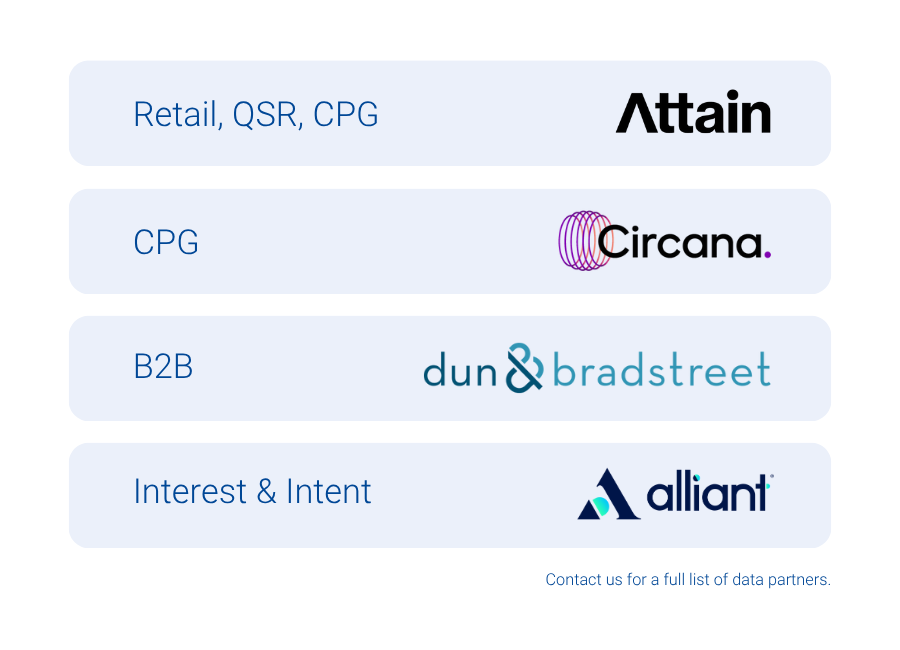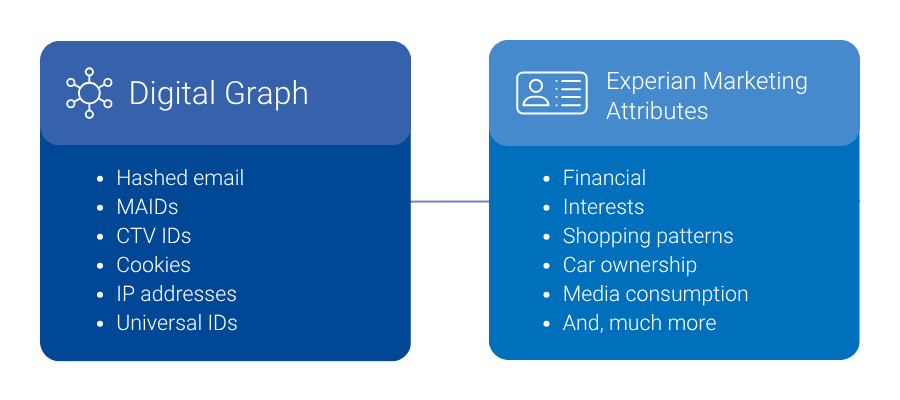
Marketers are searching for better ways to connect with their audiences across screens and prove results. Optimum Media is at the forefront of this development, helping brands plan, activate, and measure campaigns across linear TV, addressable TV, connected TV (CTV), digital, and social platforms.
To support this approach, Optimum Media partners with Experian, combining their subscriber data with Experian’s trusted audience and identity solutions.
Together, we help brands not only find the right consumers but also understand their behaviors and measure real outcomes. Here’s how Optimum Media and Experian are working together.
Build a complete customer view with rich data from Experian
Optimum Media starts with strong first-party data, including viewership and exposure information from millions of households. However, reaching a deeper understanding of these audiences requires more than what subscriber records alone can offer.
Through Experian’s Marketing Attributes, Optimum Media gains access to thousands of demographic and behavioral attributes to its data sets. These attributes—such as income ranges, lifestyle interests, and retail purchasing behaviors—help advertisers build a more complete view of the consumer.
“We work with trusted partners like Experian to deliver the additional audience insights—like demographics and lifestyle—that are critical for our clients’ success.”
Natalia Irmin, Sr. Director, Strategic Partnerships, Optimum Media
Combining Experian’s Marketing Attributes with Optimum Media’s subscriber footprint helps brands segment audiences more precisely, develop refined media plans, and tailor messaging based on the real behaviors and interests of consumers.
Move beyond basic targeting with Audience Engine
To support more personalized and scalable targeting, Optimum Media uses Audience Engine—Experian’s self-service platform for audience management and activation.
Through Audience Engine, Optimum Media can:

These tools give Optimum Media and its clients the ability to move beyond basic targeting. Whether a brand wants to reach families preparing for back-to-school shopping, in-market car buyers, or upscale consumers planning home renovations, Audience Engine makes it possible to identify and activate those audiences with greater accuracy—based on real data, not guesswork.
Extend campaign reach with Experian’s Digital Graph
While Optimum Media has a substantial owned footprint, they often work with advertisers who need to extend reach beyond traditional subscriber bases. To support this, they rely on Experian’s Digital Graph.
Our Digital Graph connects mobile ad IDs (MAIDs), IP addresses, CTV IDs, and hashed emails into unified household and individual profiles. This enables Optimum Media to identify and reach audiences outside of their network with the same level of accuracy as inside it.

For even deeper audience insights, Digital Graph can be bundled with Marketing Attributes. This combination helps advertisers go beyond basic targeting to include real-world behaviors like shopping habits, travel preferences, and lifestyle characteristics.

The result: campaigns that do more than deliver impressions—they connect with the right households across any channel.
Turn viewership into measurable business outcomes
One of the biggest challenges in multiscreen advertising is connecting exposure to real business results.
With Experian’s solutions, Optimum Media can:
- Plan based on audience behaviors across screens, not just age and gender demographics.
- Activate household-level audiences across linear, CTV, digital, and social.
- Measure campaign performance using unduplicated reach, frequency, and attribution across devices.
By offering advertisers access to a more complete consumer profile and maintaining consistent measurement across channels, Optimum Media and Experian help clients make better decisions about where to spend and how to adjust strategies over time.
Why the Optimum Media and Experian partnership delivers
- Deeper audience understanding: By combining first-party viewership with Experian’s demographic and behavioral data, advertisers gain a fuller picture of who they are reaching.
- Seamless cross-platform execution: Identity solutions like Digital Graph allow brands to reach audiences across multiple devices and channels without losing precision.
“Optimum Media has been instrumental in helping Experian strengthen the precision, quality, and real-world applications of our data. Their ongoing feedback is invaluable in making sure our solutions continue to meet client needs and perform at the highest level.”
Chris Feo, Chief Business Officer, Experian
With a single, trusted partner offering both identity and audience solutions, Optimum Media avoids the complexity many advertisers still face when piecing together different data sets and vendors.
“Having Experian’s identity and audience solutions under one roof makes it easier for us to plan, reach, and measure across every channel. It’s a complete solution that simplifies advertising and improves performance.”
Natalia Irmin, Sr. Director, Strategic Partnerships, Optimum Media
Start building better campaigns with Experian
Ready to improve your audience targeting and measurement strategies like Optimum Media?
Connect with our team today to learn how Marketing Attributes, Audience Engine, Digital Graph, and our other solutions can help you build stronger, more measurable advertising campaigns.
Connect with us
About Optimum Media
Optimum Media is a multiscreen advertising business that partners with small and medium businesses, as well as national, political, media and entertainment, and agency clients across the United States. They work with advertisers to develop custom multiscreen advertising solutions powered by proprietary technology and a massive aggregated database of audience data points and TV viewership data.
Latest posts

Note: While third-party cookies are no longer being phased out, this webinar was recorded in 2023 when cookie deprecation was still a key industry focus. The strategies discussed reflect that time frame and remain relevant for addressing broader signal loss challenges. With major browsers discontinuing support for third-party cookies, marketers must rethink how to identify and engage their audiences. Contextual advertising offers a privacy-safe solution by combining contextual signals with machine learning to deliver highly targeted campaigns. In a Q&A with our experts with eMarketer, Jason Andersen, Senior Director of Strategic Initiatives and Partner Solutions at Experian, and Alex Johnston, Principal Product Manager at Yieldmo, we discuss how contextual advertising addresses signal loss, improves addressability, and delivers better outcomes for marketers. The macro trends impacting marketers How important is it for digital marketers to stay informed about the changes coming to third-party cookies, and what challenges do you see signal loss creating? Jason (Experian): Third-party cookies have already been eliminated from Firefox, Safari, and other browsers, while Chrome has held out. It’s just a matter of time before Chrome eliminates them too. Being proactive now by predicting potential impacts will be essential for maintaining growth when the third-party cookie finally disappears. Alex (Yieldmo): Third-party cookie loss is already a reality. As regulations like the General Data Protection Regulation (GDPR) and the California Consumer Privacy Act (CCPA) take effect, more than 50% of exchange traffic lacks associated identifiers. This means that marketers have to think differently about how they reach their audiences in an environment with fewer data points available for targeting purposes. It’s no longer something to consider at some point down the line – it’s here now! Also, as third-party cookies become more limited, reaching users online is becoming increasingly complex and competitive. Without access to as much data, the CPMs (cost per thousand impressions) that advertisers must pay are skyrocketing because everyone is trying to bid on those same valuable consumers. It’s essential for businesses desiring success in digital advertising now more than ever before. Solving signal loss with contextual advertising How does contextual advertising help marketers engage audiences with new strategies like machine learning and artificial intelligence (AI)? Jason (Experian): Contextual advertising helps marketers engage audiences by combining advanced machine learning with privacy-safe strategies. We focus on using AI and machine learning to better understand behavior, respect privacy, and deliver insights. As third-party cookies go away, alternative identifiers are coming to market, like Unified I.D. 2.0 (UID2). These are going to be particularly important for marketers to be able to utilize them. As cookie syncing becomes outdated, marketers will have to look for alternative methods to reach their target audiences. It’s essential to look beyond cookie-reliant solutions and use other options available regarding advertising. Alex (Yieldmo): There’s been a renaissance in contextual advertising over the last couple of years. Three key drivers are shaping this shift: The loss of identity signals is forcing marketers to rethink how they reach audiences. Advances in machine learning allow us to analyze more granular contextual signals, identifying patterns that are most valuable to advertisers. Tailored models now use these signals to deliver more effective campaigns. This transformation is occurring because of our ability to capture and operate on richer, more detailed data. Reach consumers with advanced addressability How does advanced contextual advertising help marketers reach non-addressable audiences? Jason (Experian): Advanced contextual advertising helps marketers reach non-addressable audiences by taking a set of known data (identity) and drawing inferences from it with all the other signals we see across the bidstream. It’s about using a small seed set of customers, those who have transacted with you before or match your target audience, and training contextual models to make the unknown known. Now we can go out and find users surfing on any of the other sites that traditionally don’t have that identifier for that user or don’t at that moment in time and start to be able to advertise to them based on the contextually indexed data. Alex (Yieldmo): I think the exciting opportunity for many people in the industry is figuring out how to reach your known audience in a non-addressable space, that is based on environmental and non-identity based signals, that helps your campaign perform. Machine learning advancements allow you to take your small sample audience and uncover those patterns in the non-addressable space. High-quality, privacy-resilient data sets are critical for building these campaigns. Companies like Experian, with deep, rich training data, are well positioned to support advertisers in building extension audiences. Creative strategies that improve ad performance Why does creative strategy remain essential for digital advertising success? Jason (Experian): Creative strategy remains essential because it provides valuable signals for targeting and engages audiences effectively. In this advanced contextual world, good creative in the proper ad format that you can test and learn from is paramount. It comes back to that feedback loop. We can use that as another signal in this equation to develop and refine the right set of audiences for your targeting needs. Alex (Yieldmo): Creative and ad formats are powerful signals for understanding audience engagement. At Yieldmo, we collect interaction data every 200 milliseconds, such as scrolling behavior or time spent on an ad. This data fills the gap between clicks and video completions, helping us build models that predict downstream actions. Tailoring creative to specific audience groups has always been one of the best ways to improve performance, and it remains essential in this new era of contextual advertising. Throughout my career, I learned that designing or tailoring your creative to different audience groups is one of the best ways to improve performance. We ran many lift studies with analysis to understand how you can tailor creative customized for individual audiences. That capability and the ability to do that on an identity basis is. Our recommendations for actionable marketing strategies Do you have recommendations for marketers building out their yearly strategies or a campaign strategy? Jason (Experian): My recommendation for marketers building out their yearly strategies is to be proactive and start testing and learning these new solutions now. I mentioned addressability and being in the right place at the right time. That’s easier in today’s third-party cookie world. But as traditional identity is further constricted, you will have these first-party solutions that will not be at scale, so you’re less likely to find your user at the scale you want. It would be best if you thought about how to reach that user at the right place at the right time. They may not be seen from an identity basis. They might not be at the right place at the right time when you were delivering or trying to deliver an ad. But you increase your chance of reaching them by building these advanced contextual targeting audiences using this privacy-safe seed ‘opted-in’ user set; this is a way to cast that wider net and achieve targeted scale. Alex (Yieldmo): Build your seed lists, test your formats with different audiences, and understand what’s resonating with whom. Take advantage of some of the pretty remarkable advances in machine learning that are allowing us, really, for the first time to fully uncork the potential and the opportunity with contextual in a way that we’ve never done before. Contact us About our experts Jason Andersen Senior Director, Strategic Initiatives and Partner Solutions, Experian Jason Andersen heads Strategic Initiatives and Partner Enablement for Experian Marketing Services. He focuses on addressability and activation in digital marketing and working with partners to solve signal loss. Jason has worked in digital advertising for 15+ years, spanning roles from operations and product to strategy and partnerships. Alex Johnston Principal Product Manager, Yieldmo Alex Johnston is the Principal Product Manager at Yieldmo, overseeing the Machine Learning and Optimization products. Before joining Yieldmo, Alex spent 13 years at Google, where he led the Reach & Audience Planning and Measurement products, overseeing a 10X increase in revenue. During his time, he launched numerous ad products, including YouTube’s Google Preferred offering. To learn more about Yieldmo, visit www.yieldmo.com. About Yieldmo Yieldmo is an advertising platform that fuses media and creative to meet audiences in the moments that matter. Using proprietary data and AI, Yieldmo uses advanced targeting to deliver context-aware creative when and where it’s most effective, all while respecting user privacy. The result: ads that belong on inventory brands trust. For more information, please visit www.yieldmo.com. Contextual advertising FAQs What is contextual advertising, and how does it work? Contextual advertising works by targeting audiences based on the content they’re engaging with, rather than relying on personal identifiers or traditional tracking methods. Yieldmo's platform uses advanced contextual signals and machine learning to deliver relevant ads in privacy-safe ways. How does contextual advertising address signal loss? Contextual advertising addresses signal loss by focusing on environmental and content-based signals instead of relying on thir-dparty cookies or other traditional identifiers. Experian’s identity solutions complement this approach by enabling marketers to connect with audiences in a compliant and scalable way. Why is creative important in contextual advertising? Creative is important in contextual advertising because it engages audiences and provides valuable signals for targeting. Yieldmo’s platform collects interaction data, such as scrolling and time spent on ads, to refine campaigns and improve performance. How can marketers reach non-addressable audiences? Marketers can reach non-addressable audience through advanced contextual targeting, which uses known data, like seed audiences, to identify patterns and extend reach. Experian’s identity solutions and contextual data from, Audigent, a part of Experian, help marketers connect with these audiences in privacy-safe and effective ways. Latest posts

In 2022, Google began changing the availability of the information available in User-Agent strings across their Chromium browsers. The change is to use the set of HTTP request header fields called Client Hints. Through this process, a server can request, and if approved by the client, receive information that would have been previously freely available in the User-Agent string. This change is likely to have an impact on publishers across the open web that may use User-Agent information today. To explain what this change means, how it will impact the AdTech industry, and what you can do to prepare, we spoke with Nate West, our Director of Product. What is the difference between User-Agents and Client Hints? A User-Agent (UA) is a string, or line of text, that identifies information about a web server’s browser and operating system. For example, it can indicate if a device is on Safari on a Mac or Chrome on Windows. Here is an example UA string from a Mac laptop running Chrome: To limit the passive fingerprinting of users, Google is reducing components of the UA strings in their Chromium browsers and introducing Client Hints. When there is a trusted relationship between first-party domain owners and third-party servers, Client Hints can be used to share the same data. This transition began in early 2022 with bigger expected changes beginning in February 2023. You can see in the above example, Chrome/109.0.0.0, where browser version information is already no longer available from the UA string on this desktop Chrome browser. How can you use User-Agent device attributes today? UA string information can be used for a variety of reasons. It is a component in web servers that has been available for decades. In the AdTech space, it can be used in various ad targeting use cases. It can be used by publishers to better understand their audience. The shift to limit access and information shared is to prevent nefarious usage of the data. What are the benefits of Client Hints? By using Client Hints, a domain owner, or publisher, can manage access to data activity that occurs on their web properties. Having that control may be advantageous. The format of the information shared is also cleaner than parsing a string from User-Agents. Although, given that Client Hints are not the norm across all browsers, a long-term solution may be needed to manage UA strings and Client Hints. An advantage of capturing and sharing Client Hint information is to be prepared and understand if there is any impact to your systems and processes. This will help with the currently planned transition by Google, but also should the full UA string become further restricted. Who will be impacted by this change? Publishers across the open web should lean in to understand this change and any potential impact to them. The programmatic ecosystem supporting real-time bidding (RTB) needs to continue pushing for adoption of OpenRTB 2.6, which supports the passing of client hint information in place of data from UA strings. What is Google’s timeline for implementing Client Hints? Source: Google Do businesses have to implement Client Hints? What happens if they don’t? Not capturing and sharing with trusted partners can impact capabilities in place today. Given Chromium browsers account for a sizable portion of web traffic, the impact will vary for each publisher and tech company in the ecosystem. I would assess how UA strings are in use today, where you may have security concerns or not, and look to get more information on how to maintain data sharing with trusted partners. We can help you adopt Client Hints Reach out to our Customer Success team at tapadcustomersuccess@experian.com to explore the best options to handle the User-Agent changes and implement Client Hints. As leaders in the AdTech space, we’re here to help you successfully make this transition. Together we can review the options available to put you and your team on the best path forward. Get in touch About our expert Nate West, Director of Product Nate West joined Experian in 2022 as the Director of Product for our identity graph. Nate focuses on making sure our partners maintain and grow identity resolution solutions today in an ever-changing future state. He has over a decade of experience working for media organizations and AdTech platforms. Latest posts

Up next in our Ask the Expert series, Ben Rothke, Senior Information Security Manager, reviews two certifications that should be part of your information security strategy: Service Organization Control (SOC) 2 Type 2 and International Organization for Standardization (ISO) 27001. Tapad, a part of Experian, is 27001 and SOC 2 Type 2 compliant. Two information security certifications you can trust Seals from Good Housekeeping and Underwriters Laboratories give consumers confidence that they can trust the product that they’re buying. For IT solutions or service providers, what, or who can you turn to for that seal of approval? There are many equivalent third-party attestations you can use. But which should you trust? The International Organization for Standardization (ISO) 27001 The American Institute of Certified Public Accountants (AICPA) System and Organization Controls (SOC) International Organization for Standardization (ISO) 27001 is an international standard for information security from the ISO. ISO 27001 is globally acknowledged and sets requirements for controls, maintenance, and certification of an information security management system (ISMS). This international standard provides organizations with a framework to identify, manage and reduce risks related to the security of information System and Organization Controls (SOC) The SOC, as defined by the AICPA, is a set of audit reports. SOC reports, like 27001 certificates, are used by service organizations to give their customers the confidence they have adequate information security controls in place to protect the data that they handle. SOC 2 is an assessment of controls at a service organization regarding security, availability, processing integrity, confidentiality, and privacy. The purpose of the report is to provide extensive information and assurance to a broad range of users about the controls at a service organization that are relevant to the security, availability, and processing integrity of the systems that process user data, as well as the confidentiality and privacy of the information processed by these systems. Why ISO 27001 and SOC 2 are important The value of these third-party attestations is two-fold: Organizations can show they have passed an independent external audit Third-party attestations save organizations the time of having to do their own audits In addition to 27001 and SOC 2 Type 2 compliance, we are also certified with ISO 27017 and 27018, which are add-ons to 27001 that are specific to cloud computing. We take the security and privacy of our customers’ data as seriously as they do. Every cloud service provider (CSP) has a responsibility matrix that details what security and privacy tasks they are responsible for and which ones the customer is responsible for. Any cloud customer that needs to be made aware of what their security tasks are is putting themselves at risk. So, when you want to engage a CSP, ask them for their attestations. They worked hard for them and will be proud to share their compliance. We’re powered by decades of setting standards in marketing services At Experian, we’re a privacy-first business. We’re highly focused on respecting people, their data, and their privacy. We continue to show our dedication to information security by completing these security audits every year. The constant changes to data compliance regulations can be challenging to navigate, but you don’t have to do it alone. Contact us today. We will be your guide so you can ethically and confidently reach your customers. Contact us today Contact us today About our expert Ben Rothke, Senior Information Security Manager Ben Rothke, CISSP, CISA, is a Senior Information Security Manager at Tapad, a part of Experian. He has over 25 years of industry experience in information systems security and privacy. His areas of expertise are in risk management and mitigation, security and privacy regulatory issues, cryptography, and security policy development. Ben is the author of Computer Security – 20 Things Every Employee Should Know (McGraw-Hill), and writes security and privacy book reviews for the RSA Conference Blog and Security Management magazine. Latest posts


